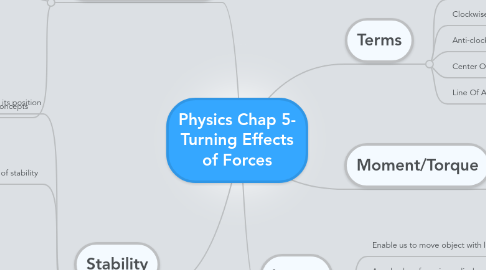
1. Center Of Gravity
1.1. Point where gravity acts on an object
1.2. If the LoA of the object doesn't go through the pivot, there is a moment (it turns)
1.3. Regular Objects
1.3.1. Center of gravity is in the center of it
1.4. Irregular Objects
1.4.1. 1) set up apparatus
1.4.2. 2) Hang plumbline in front of laminar
1.4.3. 3) Trace the plumbline to laminar
1.4.4. 4) Turn the laminar and trace the other edge
1.4.5. The intersection of the lines is the Center of Gravity
1.4.6. http://www.youtube.com/watch?v=R8wKV0UQtlo&feature=related
1.5. Concepts
1.5.1. Objects will turn till it reaches a point where there is no moment
1.5.2. If object is hung freely it will always come to rest with its Center of Gravity directly below the Pivot
2. Stability
2.1. The measure of a body's ability to maintain its position
2.2. Types of stability
2.2.1. Stable Equilibrium
2.2.1.1. Displaced slightly and it is able to maintain its position
2.2.2. Unstable Equilibrium
2.2.2.1. Displaced slightly and it changes its position
2.2.2.2. Always try to find a lower Center of Gravity
2.2.3. Neutral Equilibrium
2.2.3.1. Remains still after being Displaced
2.3. Redesign for stability
2.3.1. Lower the Center of Gravity
2.3.1.1. Increase weight
2.3.1.2. Change Material
2.3.1.3. Change to heavier material
2.3.2. Increase Base Area
2.3.2.1. Change Pivot
2.3.2.2. Chnage Center of Gravity
2.3.2.3. Change both
2.3.3. Move Center of Gravity Lower than Pivot
2.3.4. Center of Gravity below PIvot
3. Terms
3.1. Equilibrium
3.2. Clockwise Motion
3.2.1. New node
3.3. Anti-clockwise Motion
3.4. Center Of Gravity
3.5. Line Of Action
4. Moment/Torque
4.1. Turning Effect of A Force
4.2. Moment = Force x perpendicular dist. from the pivot
4.2.1. M = F x D
4.2.2. Pivot/ Fulcrum/ Hinge
4.3. SI unit = Newton Metre (Nm)
4.4. Principle
4.4.1. When an object is in equilibrium, the ∑ cwm = ∑ acwm
5. Levers
5.1. Enable us to move object with less force
5.1.1. New node
5.2. A rod- when force is applied on it, it will help move load
5.2.1. New node
5.2.1.1. New node
